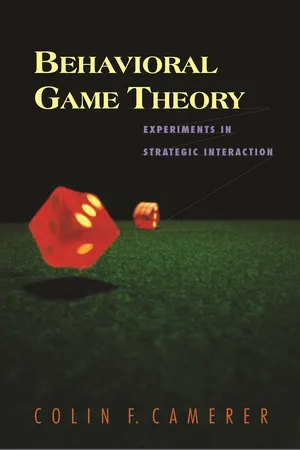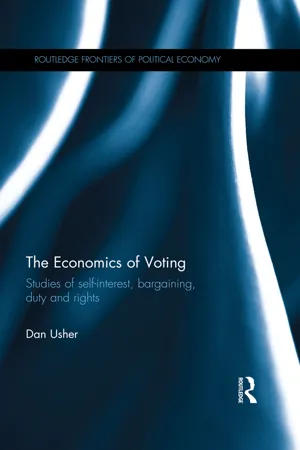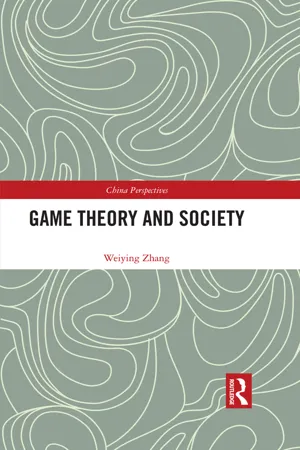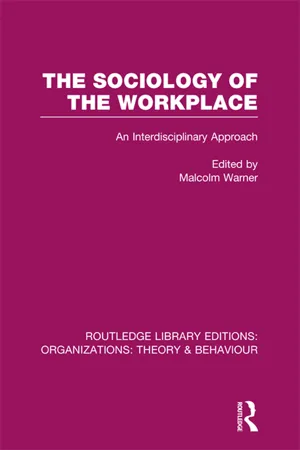Business
Nash Bargaining
Nash Bargaining refers to a negotiation model developed by mathematician John Nash. It aims to find a mutually beneficial agreement between two parties by maximizing the product of their gains. The model assumes that both parties are rational and seek to maximize their own benefits, leading to a fair and efficient outcome.
Written by Perlego with AI-assistance
Related key terms
Related key terms
1 of 4
Related key terms
1 of 3
10 Key excerpts on "Nash Bargaining"
- eBook - ePub
The Persuasive Negotiator
Tools and Techniques for Effective Negotiating
- Florence Kennedy Rolland(Author)
- 2020(Publication Date)
- Routledge(Publisher)
What is true for you must be true for the other negotiator, so it is fair to conclude that you both negotiate because you both expect to gain something over what you have before your bargain. Briefly put, the Nash Bargaining problem is not about how you arrive at a solution – it is solely about the content of the solution. This leaves the problem of how to arrive at a solution unaddressed and, therefore, unsolved by Nash. For those not exposed to economic theory, Nash’s assumptions seem naïve compared with the circumstances commonly found in real-world bargaining processes. Nash, for instance, assumes: • highly rational bargainers who can accurately compare each other’s desires for various things; • bargainers who have equal ‘bargaining skills’; • bargainers who have full knowledge of the tastes and preferences of the other; and • bargainers who desire to maximise their gains in bargaining. His model of bargaining uses numerical utility theory, which is an economist’s way of ‘measuring’ the satisfaction, however defined, that an individual receives from possessing this or that set of goods. Nash, fortunately, provided an arithmetical example to demonstrate his solution. He refers to Bill and Jack, though they are not brothers, nor do they have a convenient adjudicator (their elder sister, Louise). That was my device to introduce you to the Nash solution. Before trading, Bill and Jack enjoy various numerical utilities from their possessions (see Table 8.2). It is the differences in their priorities or valuations that enable Bill and Jack to solve their exchange problem. Because each of them wants something from the other, they can find mutually acceptable terms for the trade - eBook - ePub
The Roundtable Series in Behavioral Economics
Experiments in Strategic Interaction
- Colin F. Camerer(Author)
- 2011(Publication Date)
- Princeton University Press(Publisher)
4BargainingBARGAINING IS THE PROCESS by which economic agents agree on the terms of a deal. Defined this broadly, bargaining is possibly the most basic activity in economic life. Even in thick, competitive markets where traders closely resemble the “price-takers” of economic theory, haggling occurs over time of delivery, repairs, side payments, and quality, as well as price. Prices on commodities exchanges, for example, are actually bargains between traders who shout at each other in the pit.Since bargaining is central to economic life, it has been the subject of constant attention. Edgeworth (1881) created the famous “Edgeworth box” to show the range of possible outcomes of a bargain, but was frustrated by his inability to reach a unique solution. Zeuthen (1930) and Hicks (1932) later defined theories of bargaining which proceeded in several steps, to describe bargaining as it often takes place and to come to a sharp prediction about what outcomes would result. Nash (1950, 1951) approached bargaining in two different ways. First, he proposed a series of axioms that any reasonable bargaining solution should obey, and showed that maximizing the product of the agents' utilities (beyond their utilities from an exogeneous “threat point”) was the solution that uniquely satisfied his axioms (subsequently called the “Nash Bargaining solution”). Second, in a quite different paper, he proposed a “noncooperative” solution in which predicted outcomes depend on the structure by which the bargaining took place. Nash envisioned a unification of the two approaches—the “Nash program.” The unification finally came in the 1980s, when Binmore, Rubinstein, and Wolinsky (1986) showed that subgame perfect equilibria of noncooperative games with a certain alternating-offer structure were the same as the utility product maxima prescribed by the Nash Bargaining solution. - eBook - ePub
Tariff Determination in the General Equilibrium of a Political Economy
A Bargain-theoretic Approach to Policy Modelling
- Hom Moorti Pant(Author)
- 2019(Publication Date)
- Routledge(Publisher)
To solve a bargaining problem, several solution concepts have been proposed in the literature. The Nash solution is one of them. A short review of these solution concepts can be found in Datt (1989). He has also convincingly argued that Nash solution has a degree of generality not shared by other solution concepts. Several other studies that attempted to solve a standard bargaining problem by introducing various frictions into it have concluded that Nash solution is robust (see, Binmore, Rubinstein and Wolinsky, 1986; van Damme, 1986; Chun, 1988b; Chun and Thomson, 1990; Carlson, 1991).Nash (1950, 1953), who studied 2-person bargaining games, defined a solution of a bargaining game in B as a function µ:B→R2 such that for any (ℜ,Πd ) ∈B we have µ(ℜ,Π2 ) ∈ℜ . in other words, a solution of the game is a rule for assigning a feasible payoff to each player. Roth (1979) has argued that this rule can also be interpreted as an arbitration procedure.Nash (1953), in his seminal paper, used both strategic and axiomatic approaches to analyse the bargaining problem. In the strategic approach, he constructed a negotiation model, so-called ‘demand game’, in which each player (in a 2-person game) demands a particular utility payoff. If the demands of both the players are jointly compatible, then each one gets what is demanded; otherwise each receives the predetermined disagreement payoff.4 Nash has shown that rational bargainers will agree on the payoff division that maximizes the Nash product over the feasible set.In the axiomatic approach, Nash (1953) listed a set of eight general properties that any reasonable solution to the bargaining problem should possess. A deduction of logical solutions that satisfy the ‘desirable’ properties led Nash to the same solution that he obtained from the negotiation model – that the solution should maximize the Nash product! Nash, therefore, wrote,It is rather significant that this quite different approach yields the same solution. This indicates that the solution is appropriate for a wider variety of situations than those which satisfy the assumptions we made in the approach via the model (p. 136). - eBook - ePub
- Dan Usher(Author)
- 2015(Publication Date)
- Routledge(Publisher)
In the standard model of the competitive economy, universal self-interest can be relied upon to generate prices, quantities and the distribution of income in response to initial conditions of ownership and to technical constraints. The model tells us when equilibrium is to be expected, when, and in what sense, outcomes are socially optimal and when public intervention might be warranted. One seeks for analogous results from models of bargaining: reliance on self-interest, proof of equilibrium in the core model and recognition of circumstances where the assumptions of the core model are violated. The claim in this chapter is that the analogy does not hold. Bargaining models yield determinate equilibria, but only on the strength of assumptions with too little distance from what is to be proved or because what is called bargaining in such models is very different from bargaining as commonly understood. Confidence in people’s capacity for bargaining and compromise comes from experience rather than theory, but we also know that bargaining fails from time to time. Large sums are sometimes divided up painlessly; friendships or valuable partnerships may be destroyed in disputes over trifles. Bargaining models may be downright misleading by suggesting determinacy in circumstances where there is none. Bargaining and compromise cannot be subsumed under the heading of self-interest in response to external constraints. Bargaining remains unexplained.Bargaining is everywhere: in wage setting between employers and employees, in allocating tasks and rewards between partners in business, in patent pools, in deals to avert costly litigation, in the formation of platforms of political parties, in allocating cabinet posts in coalition government, in reconciling of House and Senate versions of a bill, in deals between nations to avert the descent into war, in attempts by Sunnis and Shiites in Iraq to forge a viable government. If the argument in this chapter is correct, outcomes depend on something more than a mechanical resolution of competing interests.This chapter begins with an exposition of the paradigmatic bargain where two people are jointly entitled to a pie if and only if they can agree about how large each person’s slice is to be. The bargaining problem is to determine which among the many mutually advantageous bargains will actually be struck. Three bargaining solutions are then examined within the framework of the paradigmatic bargain: the Nash (1950) bargaining solution based upon a common sense of fairness, Hicks’ (1932) and Zeuthen’s (1930) models of concessions in proportion to harm from failure to agree and the Staahl–Rubinstein solution (Staahl (1972) and Rubinstein (1982)), based upon an imposed bargaining procedure. The models are described simply to highlight their implicit assumptions and to emphasize the contrast between bargaining as depicted in models and bargaining as it is commonly understood to be. There is finally a list of the critical simplifications in the paradigmatic bargain together with discussion of what happens when these simplifications are replaced. A simple proof of the Staahl–Rubinstein bargaining solution with emphasis on implications of variations in the assumptions is presented as an appendix. - eBook - ePub
Games and Decisions
Introduction and Critical Survey
- R. Duncan Luce, Howard Raiffa, Howard Raiffa(Authors)
- 2012(Publication Date)
- Dover Publications(Publisher)
3 But, rather than do this, our strategy will be, first, to consider a special class of conflicts, called bargaining games, in which we can illustrate in detail the mathematical counterparts of some of the above verbal conditions. Then, second, we will turn to the more complex case of the general two-person non-strictly competitive game; however, we shall not study it in the same detail as the bargaining games.6.5 NASH’S BARGAINING PROBLEM“The economic situations of monopoly versus monopsony, of state trading between two nations, and of negotiation between employer and labor union may be regarded as bargaining problems.” [Nash, 1950 b.] The task is to give a formal definition of a bargaining problem and to solve it; this Nash has attempted, and we shall discuss his work on bargaining in this and the following section.Consider two individuals, 1 and 2, who “are in a position where they may barter goods but have no money to facilitate exchange,” but who do have the facilities to perform randomized experiments. Each comes to the market with an initial bundle of goods, and a trade takes place if and only if each consents to it. By a trade we mean an actual reapportionment of the joint bundle of goods held by them. Let T, T′, etc., denote different possible trades. In the class of all possible trades there is one which is distinguished, namely, when no trade actually occurs—the status quo. This we denote by T*.We shall suppose that each player’s preferences over randomized outcomes are consistent in the sense of Chapter 2 , and so they may be mirrored by a numerical utility index. Thus, associated to each trade T is a pair of utilities representing, respectively, the utility of T for 1 and 2. Denote the utility pair of In this way, each trade T can be represented as a point in the plane. If T is represented by and T′ by a randomization between T and T’ is represented by a specific point on the line segment joining and and, conversely, any such point represents a randomization between these trades.Let R denote the set of all points representing trades and randomizations between trades. R is bounded, convex, and closed (i.e., it contains its boundary). In Fig. 4 a typical R - eBook - ePub
- Weiying Zhang(Author)
- 2017(Publication Date)
- Routledge(Publisher)
5Bargaining and patienceAny transaction could be seen as a bargaining game. Reaching an agreement is the common interest of both parties; thus, it is Pareto improvement. However, different agreements mean different allocations of interest, so conflicts of interest exist.There are two approaches for analyzing the bargaining issue: The cooperative game approach and the non-cooperative game approach. Collective rationality is the starting point of the cooperative game approach and individual rationality is the starting point of the non-cooperative game approach.According to the cooperative game approach, the bargaining solution is determined by the bargaining power and bargaining strength (marginal contribution to the value creation) of parties involved. If the parties are symmetric, then the Nash Bargaining solution means they will evenly distribute the surplus value brought about by the transaction. This conclusion provides a source of fairness.According to the non-cooperative game approach, the bargaining equilibrium outcome is determined by the bargaining sequence (who bids first), the number of times bargaining takes place, the patience of the people involved, the cost of bargaining, etc. The more patient a person is, and the lower his cost of bargaining is, the more advantage he will have during the negotiation. If both parties are symmetric and allowed to bargain an unlimited number of times, then the perfect Nash equilibrium allocation is almost evenly split.In reality, negotiation often take many rounds, and an agreement might not even be reached. This is primarily because information about the value of the transaction, bargaining power, and patience is incomplete. The process of negotiation is actually a process of both parties mutually obtaining information about the other.People’s behavior during negotiations is restricted by social norms. These social norms include procedural norms and substantial norms. Violating these social norms will lead to a breakdown in negotiations. Experiments with “The Ultimatum Game” show that the fairness concept held by most people, and has an important impact on the outcome of negotiations. However, this does not prove that people are irrational. Misalignment between theoretical projections and reality are primarily because theorists have too little information. - eBook - ePub
Game Theory
A Modeling Approach
- Richard Alan Gillman, David Housman(Authors)
- 2019(Publication Date)
- Chapman and Hall/CRC(Publisher)
Chapter 4Bilateral AgreementsWhen two players can communicate and enter into a binding agreement, they can achieve an efficient solution. We first examine two pure bargaining scenarios and their resolution by the egalitarian, Raiffa, and Nash solution methods. Next, we show how any strategic game can be considered a bargaining game when binding agreements are permitted. Finally, we characterize the three solution methods axiomatically, modeling fairness with formal properties and thereby providing one way of selecting the appropriate solution in a given scenario.In a strategic game, players announce strategy choices simultaneously with no prior knowledge of each other’s choices. Although communication may be permitted, no binding agreements are allowed. In bargaining games, players must negotiate and reach a binding agreement as to which payoff pair and resulting outcome they collectively choose.Definition 4.0.1. A bilateral bargaining game consists of the following:1.A set N = {1, 2} of two players.2.A set O of outcomes that includes a disagreement outcome o d ∈ O .3.A rule stating the game ends when both players agree upon an outcome o ∈ O , or a pre-specified time limit is reached resulting in the disagreement outcome, o d .4.Utility functions u i : O → ℝ that specify the preferences for each player i ∈ N .The feasible payoff pairs are F = {(u 1 (o ), u 2 (o )): o ∈ O }, and the disagreement payoff pair is d = (d 1 , d 2 ) = (u 1 (o d ), u 2 (o d )).The players can bargain over the feasible payoff pairs in order to avoid the disagreement payoff pair. Once a payoff pair has been determined, a corresponding outcome can be chosen.While we limit ourselves to two players in this chapter, the model and its solutions can be readily generalized to any number of players as long as there are no advantages for proper subsets of players to enter into an agreement.4.1NegotiationsThere are many scenarios in which negotiations occur between two parties. Friends negotiate where to go to dinner, consumers negotiate prices with vendors, and countries negotiate bilateral trade agreements. We begin with the simple example of sharing a prize at the county fair. - eBook - ePub
- Roger A McCain(Author)
- 2013(Publication Date)
- WSPC(Publisher)
Chapter 2
Zeuthen—Nash Bargaining
While bargaining theory is sometimes treated as a subfield of game theory, it is more accurately described as an independent field that overlaps game theory. The earliest work (Zeuthen, 1930; Hicks, 1932; Pen, 1952) preceded the widespread awareness of game theory, and important work continued outside game theory (e.g., Bishop, 1964; Coddington, 1966; Cross, 1975; Saraydar, 1965). Union-management bargaining over a wage rate was often treated as the paradigmatic case. However, the contributions of John Nash (1950, 1953) to bargaining theory as game theory (or conversely) have been as widely influential as any, and give the earliest example of a value solution for a class of cooperative games, together with a call that value solutions should be applicable to all cooperative games (Nash, 1950, p. 157). Thus Nash’s theory, and some of its generalizations, will be central to the purposes of this book.2.1. Nontransferable Utility GamesNash (1950, p. 155) addresses a situation in which “two individuals…have the opportunity to collaborate for mutual benefits in more than one way.” The different forms their collaboration may take result in different assignments to the two individuals of the benefits from collaboration. Either there are no side payments or it may be impossible by means of side payments to reallocate utility among the agents unit for unit. Thus, Assumption TU is not applicable, and Nash’s bargaining theory is applicable to two-person nontransferable utility (NTU) games. In fact, TU games are a special case of NTU games, and Nash Bargaining can be applied to two-person TU games; however, the extension to NTU games is important.As before, a numerical example will illustrate this. Consider Game 2.1 , shown in strategic normal form in Table 2.1 - Malcolm Warner(Author)
- 2013(Publication Date)
- Routledge(Publisher)
When a distinction does arise, the term bargaining will refer to the process of demand formation and revision which provides the basic mechanism whereby the parties seek to come towards an agreement. The term ‘negotiation’ will refer to the situation within which bargaining occurs. The key concepts included in the definition of a formal negotiation are : that it refers to an occasion where one or more representatives of two or more parties interact in an explicit attempt to reach a jointly acceptable position over one or more divisive issues.[ 2 ] Such occasions are distinguishable from informal negotiations in which individuals either discuss topics on which they happen to disagree or alternatively where each person comes to terms entirely on his, or her, own behalf. Negotiations are concerned with the voluntary process of distributing the proceeds of cooperation. They arise whenever the allocation of gains between the parties to an agreement are subject to their own choice rather than predetermined by circumstances which lie outside the control of the actors.[ 3 ] It is also implied that both parties stand to benefit by reaching an agreement and that the moves made during the process are made voluntarily. Negotiating as defined here is always characterized by some form of communication no matter how imperfect. The divisive characteristic of negotiations emphasizes that one is concerned with the distribution of values. If there were no value distribution there would be no bargaining.[ 4 ] The benefits, or payoffs, which accrue to either party tend to be lower until both sides have accepted the terms of an agreement. Intermediate payoffs before an agreement is reached may be of symbolic value but if overemphasized they may result in a failure to reach a jointly acceptable position. The bargaining process, although emphasized as being a distributive device, also has a productive characteristic- eBook - ePub
Agricultural Marketing
Structural Models for Price Analysis
- James Vercammen(Author)
- 2012(Publication Date)
- Routledge(Publisher)
13 The purpose of this section is to show that the bargaining outcomes for the board and the processor are the same with the two alternative bargaining models in the limiting case where Δ → 0.The asymmetric version of the Nash Bargaining solution is obtained as the outcome to the following optimization problem:Within equation (9.6) the parameter θ reflects the relative bargaining strength of the two players and the D variables are referred to as “threat” or “disagreement” points. Maximizing the natural log of equation (9.6) subject to πB+ πP= π will give the desired solution and is mathematically easier to work with. Hence, the Lagrange function for this optimization problem with λ serving as the Lagrange multiplier can be written as:The first-order conditions for optimally choosing πandBand πPare dL/dπB= θ (πB− DB)–1 – λ = 0, dL/dπP= (1 − θ) (πP− DP)–1 – λ = 0, and πB+ πP= π. Solving the first pair of equations gives (1 − θ)(πB− DB) = θ(πP− DP). This equation, together with πB+ πP= π, results inNotice that equation (9.8) has the same general structure as the expression for equilibrium profits in the sequential bargaining game as given by equation (9.4) . Specifically, the D (disagreement) variables take the place of the Z (inside option) variables and the bargaining strength parameter, θ takes the place of the discount rate ratio, rP/(rB+ rP
Index pages curate the most relevant extracts from our library of academic textbooks. They’ve been created using an in-house natural language model (NLM), each adding context and meaning to key research topics.
Explore more topic indexes
Explore more topic indexes
1 of 6
Explore more topic indexes
1 of 4









